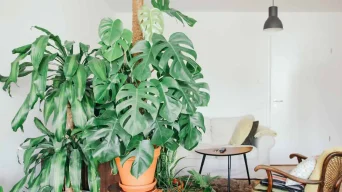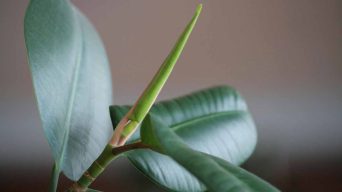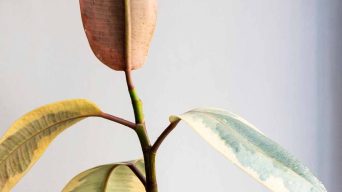To keep your rubber plant healthy, ensure it is placed in a bright room away from direct sunlight with a temperature between 15°C to 25°C. Water the plant when the soil is almost dry and mist it every few days for optimal humidity. Additionally, wipe away dust from its leaves and feed it with liquid fertilizer once a month in spring and summer.
Are you a proud owner of a Ficus elastica, commonly known as a rubber plant, or are you considering adding one to your corner of green? Read on, because you’ve come to the right place.
What if we told you this unassuming glossy-leaved Ficus Elastica in your lounge is not merely another decorative houseplant but a spectacular symbol of good health and prosperity with remarkable air-purifying abilities?
In this blog post, we’ll dig into caring for these resilient tropical wonders, revealing intriguing facts about their contribution to home aesthetics and well-being.
Get ready to unlock the secrets of maintaining a vibrant rubber plant that will not only adorn your space but also boost your mood and purify your indoor atmosphere!
Facts and Statistics
- Research from the University of Florida states that rubber plants (Ficus elastica) under optimal indoor conditions can grow between 1 to 2 feet annually.
- According to a NASA clean air study, the Ficus elastica has been rated among the top ten houseplants for removing formaldahyde, xylene, and other toxins from the air.
- A study published in 2020 by the Journal of Arboriculture and Urban Forestry highlights that rubber plants have water-storing properties. The plant requires watering only when the top inch of soil is dry, roughly every one to two weeks depending on conditions. Overwatering can lead to leaf yellowing or root rot.
Ficus Elastica Overview
The history of rubber trees traces back to their origins in Southeast Asia. Indigenous to regions such as India, Nepal, China, Burma, and Malaysia, these plants have been cultivated for centuries due to their impressive latex production abilities.
The milky white latex found within the veins of the rubber plant is what gives it its name.
In the 19th century, British explorers became captivated by these latex-rich trees during expeditions to explore new lands.
They discovered that extracting and processing this latex could yield valuable products like rubber tires and other industrial materials. This groundbreaking discovery revolutionized various industries worldwide.
The popularity of rubber plants as ornamental houseplants surged in the late 1800s when they were brought to Europe and North America from their native habitats.
Their unique foliage and adaptability made them an instant hit among horticulture enthusiasts.
Understanding the historical background of rubber plants allows us to appreciate their journey from the lush forests of Southeast Asia to becoming a cherished indoor plant in homes around the world.
Benefits of Having Rubber Plants
Rubber plants have gained immense popularity in recent years, not just for their striking appearance but also for their numerous benefits.
Whether you’re a seasoned plant enthusiast or just starting your green journey, incorporating a rubber plant into your space can bring about positive changes that go beyond aesthetics.
From improving air quality to boosting productivity, here are some compelling reasons why having a rubber plant in your home or office can be truly rewarding.
One of the primary advantages of having a rubber tree plant is its ability to purify the air. Like other houseplants, rubber plants absorb toxins in the air through their leaves and convert them into oxygen.
Through the process known as phytoremediation, these plants can effectively remove harmful substances such as formaldehyde and benzene from indoor environments.
I remember a time when my allergies would act up whenever I entered certain rooms in my house. But after adding a rubber plant to those spaces, I noticed a significant improvement in air quality, which resulted in reduced symptoms and increased comfort.
Additionally, rubber plants are known to enhance concentration and productivity.
Research has shown that being surrounded by nature can have a positive impact on cognitive abilities, focus, and overall well-being.
The lush green foliage of a rubber plant brings a touch of nature indoors and creates a calming environment that can help alleviate stress and promote mental clarity.
Numerous studies suggest that having plants nearby while studying or working can improve performance and increase attention span.
Moreover, having a rubber plant in your living space can improve humidity levels. Rubber plants release moisture into the air through a process called transpiration, which helps combat dryness that often occurs during winter months or in arid climates.
However, it’s important to note that while this may benefit some individuals, others who live in humid regions might find excessive humidity to be a potential drawback.
In such cases, it is advisable to monitor humidity levels and consider alternative solutions like using a dehumidifier if necessary.
Similar to how having a furry companion can help uplift our spirits, owning a rubber plant can bring a sense of joy and companionship.
Taking care of a living thing and watching it thrive can be incredibly rewarding.
The simple act of nurturing a rubber plant not only adds a touch of nature to your surroundings but also provides an opportunity for personal growth. It teaches patience, responsibility, and the importance of consistent care.
Like having a loyal friend by your side, the presence of a rubber plant can instill a sense of calmness and tranquility in your daily life, reminding you to slow down and appreciate the beauty around you.
Undoubtedly, there are numerous benefits to be enjoyed by having a rubber plant in your home or office. From purifying the air to improving concentration, these beautiful plants offer more than just visual appeal.
As we delve into the essential care routines for maintaining a healthy rubber plant, it’s important to understand how these benefits play a crucial role in maximizing the lifespan of your beloved green companion.
Let’s now explore the key requirements for providing proper care and nourishment to ensure the longevity and vitality of your rubber plant.
Essential Care for a Healthy Rubber Plant
Caring for a rubber plant is relatively easy once you grasp its basic needs.
Attention to these key factors will ensure that your rubber plant thrives and continues providing numerous benefits.
Light Requirements
Rubber plants prefer bright, indirect light.
Placing them near a north or east-facing window is ideal as it provides the right balance of natural light without exposing the plant to direct sunlight for prolonged periods.
Direct sunlight can scorch the leaves and cause them to curl or develop brown spots.
If your rubber plant isn’t receiving enough light, it may become leggy and have sparse growth.
Temperature
Rubber plants are tropical in nature, thriving in temperatures between 15°C to 25°C (59°F to 77°F).
They are sensitive to extreme cold or hot temperatures, so it’s important to keep them away from drafts, heating vents, or air conditioning units that could create temperature fluctuations.
Maintaining a stable temperature will contribute to the overall health and vitality of your rubber plant.
Watering
The key to watering a rubber plant is to strike a balance.
Overwatering can lead to root rot and other moisture-related problems, while underwatering can result in drooping leaves and stunted growth.
Water your rubber plant when the top inch of soil feels almost dry to the touch. Ensure thorough watering with each session, allowing water to flow out of the drainage holes at the bottom of the pot before discarding any excess water.
Caring for a rubber plant is like taking care of yourself – finding the right balance of light and temperature, giving yourself adequate hydration without going overboard.
Some may argue that specific watering schedules should be followed for all plants.
While a regular watering routine can be helpful, it’s important to adapt your watering frequency based on the specific needs of your rubber plant.
Factors like humidity levels and temperature can influence how quickly the soil dries out. Therefore, it’s crucial to monitor the moisture level in the soil and adjust your watering accordingly.
With these essential care tips, you’ll be well on your way to maintaining a healthy and vibrant rubber plant that not only adds beauty to your space but also improves air quality.
Light, Temperature and Watering Requirements
The key to maintaining a healthy rubber plant lies in understanding its specific light, temperature, and watering requirements. As a tropical plant, the rubber plant thrives in bright, indirect light.
Placing it near a north-facing window or providing filtered sunlight will ensure optimal growth. However, direct sunlight should be avoided as it can scorch the leaves.
When it comes to temperature, rubber plants prefer a consistent environment within the range of 15°C to 25°C (59°F to 77°F). They are not tolerant of extreme cold or hot temperatures, so it’s important to keep the plant away from drafts or heating vents that may cause fluctuations.
While rubber plants are relatively drought-tolerant, they still require regular watering to maintain their health. It is best to water the plant when the top inch of soil feels almost dry to the touch.
Overwatering can lead to root rot and other issues, so allowing the soil to partially dry out between waterings is crucial.
A helpful technique is to feel the weight of the pot before and after watering. This way, you can gauge how heavy it should feel when adequately watered and determine when it’s time for another watering session.
Additionally, misting the leaves with water every few days using a mister can help provide some humidity while keeping dust accumulation at bay.
Remember that individual environmental factors like humidity levels and pot size can influence your rubber plant’s watering needs. Observe the condition of the soil and adjust your watering frequency accordingly.
Now that we’ve covered the essential care aspects related to light exposure, temperature, and watering requirements, let’s move on to discuss repotting and fertilizing procedures for your rubber plant.
Repotting and Fertilizing Procedures
As your rubber plant grows, there may come a time when it outgrows its current pot. Repotting is essential to provide the plant with enough space for its expanding root system.
Signs that your rubber plant may need repotting include roots poking out of the drainage holes, slow growth, and a general decline in health.
When repotting, choose a pot that is one size larger than the current one and make sure it has proper drainage. Gently remove the plant from its current container, loosening any tightly packed soil around the roots.
Place fresh, well-draining potting soil at the bottom of the new pot, then position the plant in the center, filling up the sides with additional soil.
Water thoroughly after repotting to help settle the plant in its new home.
Aside from repotting, another vital aspect of caring for your rubber plant is fertilizing.
During the spring and summer months, when the plant is actively growing, it can benefit from regular feeding with a balanced liquid fertilizer. This will provide the necessary nutrients to support healthy foliage development.
Before applying any fertilizer, ensure that your rubber plant is adequately watered to avoid fertilizing dry soil. Follow the instructions on the fertilizer packaging regarding dosage and frequency.
Over-fertilizing can lead to chemical burn and damage to the plant’s roots.
A helpful tip is to dilute the fertilizer to half strength and apply it once a month during spring and summer.
As always, monitor your rubber plant’s response to fertilizer and adjust accordingly based on its growth and overall health.
Now that we’ve discussed repotting and fertilizing procedures for your rubber plant, let’s explore common signs of an unhealthy rubber plant and how to prevent them.
Signs of an Unhealthy Rubber Plant and How to Prevent It
A healthy rubber plant is a sight to behold, with its lush green foliage and elegant presence. However, just like any living organism, these plants can encounter issues that can jeopardize their well-being.
By being observant and proactive, you can identify the signs of an unhealthy rubber plant early on and take necessary steps to remedy the situation.
One of the most common signs of an unhealthy rubber plant is yellowing or browning leaves. This discoloration may occur due to overwatering or underwatering.
To prevent this, it’s important to find the right balance when watering your plant. Ensure that the soil is almost dry before watering again, as overwatering can lead to root rot and leaf loss.
Another indication of an unhealthy rubber plant is wilting or drooping leaves. This could be a sign of inadequate light or extreme temperatures.
Rubber plants thrive in bright but indirect sunlight, so make sure they are positioned in a room with sufficient natural light. Also, avoid exposing them to drafts or extreme temperatures, which can cause stress and result in drooping leaves.
If you notice sticky residue on the leaves or tiny insects crawling around, your rubber plant might have a pest infestation.
Common pests that affect rubber plants include spider mites, mealybugs, and scale insects.
Regularly inspect your plant for any signs of pests and take appropriate measures to eliminate them. This may involve using insecticidal soap or wiping down the leaves with a mild detergent solution.
Keep in mind that prevention is key when it comes to maintaining a healthy rubber plant. Regularly dust off the leaves with a soft cloth or sponge to keep them clean. Dust accumulation can block sunlight absorption and hinder the plant’s overall health.
Maximizing the Lifespan of Your Rubber Plant
Rubber plants are known for their longevity and can be an enduring presence in your home for years to come.
With proper care and attention, you can ensure that your rubber plant thrives and reaches its full potential.
Here are some key strategies to maximize the lifespan of your rubber plant:
Firstly, find the ideal spot for your rubber plant. They prefer bright rooms with normal room humidity and should be positioned away from direct sunlight to prevent leaf burn.
For example, placing it near a north-facing window or a few feet away from an east or west-facing window can provide the right amount of light without exposing it to harsh rays.
Next, repot your rubber plant if you notice roots poking out of the nursery pot.
Repotting provides fresh soil and room for growth. Choose a well-draining potting mix suitable for indoor plants, allowing excess water to drain away effectively while retaining necessary moisture.
During spring and summer, give your rubber plant extra attention by using liquid fertilizer once a month. This helps provide essential nutrients for healthy growth and vibrant foliage.
Additionally, wiping the leaves periodically with a damp cloth removes dust buildup, allowing them to fully absorb light and photosynthesize efficiently.
Regularly monitor your rubber tree for any changes in appearance or signs of distress. Catching problems early on can significantly increase the chances of recovery.
Remember to check for pests, discoloration, or wilting leaves regularly and take prompt action to address these issues.
Just like tending to a flourishing garden requires ongoing care and observation, nurturing a healthy rubber plant demands diligence and attentiveness.
By following these care tips and staying vigilant, you can create an environment where your rubber plant thrives.
Remember that each plant is unique, so pay attention to its specific needs and adjust your care routine accordingly. With time, patience, and a little green thumb, you can enjoy the beauty and benefits of a healthy rubber plant for years to come.
Final Thoughts
Caring for a rubber plant is not just about maintaining a beautiful indoor companion; it’s about fostering a living symbol of health and prosperity with incredible air-purifying capabilities.
As we’ve explored the essential care tips, benefits, and fascinating history of rubber plants, it becomes clear that these resilient tropical wonders offer far more than just aesthetics.
They enhance air quality, boost concentration, and productivity, and bring a sense of joy and companionship to your space.
çBy following the guidelines for light, temperature, watering, and proactive pest prevention, you can ensure your rubber plant thrives and continues to provide numerous rewards.
Just as tending to a garden requires diligence and patience, nurturing a healthy rubber plant offers a chance to slow down, appreciate the beauty around you, and enjoy its many benefits for years to come.







